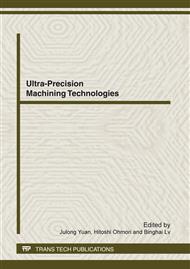[1]
X. Wei, W. Xiong, R.W. Huang: Diamod & Abrasives Engineering, No. 5 (2004), p.40.
Google Scholar
[2]
Information on http: /www. electronchem. org/meetiongs/scheduler/absttracts/210/1150. pdf.
Google Scholar
[3]
H. Zhou, D.P. Wang, B. Wang, X.F. Chen, Y.X. Ye: Mechanical Engineering & Automation No. 6 (2008), p.73.
Google Scholar
[4]
W. Hu, X. Wei, X.Z. Xie: Manufacturing Technology & Machine Tool No. 1 (2008), p.77.
Google Scholar
[5]
B. Liu: Study on the Effects of the Surface Texture and Constituent of the Pad in CMP [D]. Da Lian: Da Lian university of technology(2006).
Google Scholar
[6]
W. Xiong: Study on the performance of polishing pad in chemical-mechanical polishing [D]. Guangdong: Guodong University of Technology, (2006).
Google Scholar
[7]
P. Gregory, U.S. Patent 7018274 (2006).
Google Scholar
[8]
L. Carolina, D. Elmuf, P. Gregory, U. S . Patent 7267610 (2007).
Google Scholar
[9]
P. Gregory, U. S . Patent 6974372 (2005).
Google Scholar
[10]
K. Toshiroh, S. Kiyoshi, S. Keisuke, et al: Journal of The Electrochemical Society Vol. 15 No. 3(2004), p.196.
Google Scholar
[11]
D. Rosales-Yeomans, T. Doi, M. Kinoshita, et al: Journal of The Electrochemical Society Vol. 152 No. 1(2005), p.62.
Google Scholar
[12]
B. Len, C. Leslie: Journal of The Electrochemical Society Vol. 151 No. 12(2004), p.809.
Google Scholar
[13]
H. Thomas, H. Osterheld,C. Chih, R. Erik, U.S. Patent 6241596 (2001).
Google Scholar
[14]
P. Gregory, U. S . Patent 7125318(2006).
Google Scholar
[15]
P. Gregory, U.S. Patent 7059950(2006).
Google Scholar
[16]
P. Gregory, U.S. Patent 7311590(2007).
Google Scholar
[17]
P. Gregory, U.S. Patent 7520796(2009).
Google Scholar
[18]
L. Carolina, P. Gregory, U.S. Patent 7059949(2006).
Google Scholar
[19]
SKC CO. ,LTD, W.O. Patent 03/017347(2003).
Google Scholar
[20]
L. Carolina, J. Jeffrey, P. Gregory, U.S. Patent 7131895(2006).
Google Scholar
[21]
P. Gregory, U.S. Patent 6783436(2004).
Google Scholar
[22]
V. Ravichandra, U.S. Patent 6958002(2005).
Google Scholar
[23]
A. Peter, J. Bradley, U. S . Patent 5645496(1997).
Google Scholar
[24]
L. Carolina, V. Ravichandra, U. S . Patent 7270595(2007).
Google Scholar


